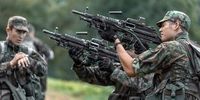In the wake of escalating global tensions, Swiss military historian Stig Förster argues that the nation must reconsider its long-standing policy of armed neutrality. Förster, who recently published his extensive work, "Deutsche Militärgeschichte," after eight years of research, believes that Switzerland's reliance on outdated military technology could leave it vulnerable in an increasingly dangerous world.
Förster, who taught at the University of Bern until his retirement, reflects on Switzerland's historical military prowess, stating, "The Swiss were considered the most feared infantry in Europe" during the 15th and 16th centuries. This reputation was built on innovative tactics, such as the use of the "Gewalthaufen" formation, which allowed ordinary men to participate effectively in warfare. However, he warns that today’s military landscape is vastly different, dominated by advanced weaponry like long-range missiles and drones.
In an interview, Förster expressed concern over the current geopolitical climate, pointing to the ongoing conflict in Ukraine as a stark reminder of the dangers of armed neutrality. He noted that while Switzerland has managed to avoid direct conflict, this may not hold true in the future. "Armed neutrality is only effective as long as neighboring countries respect it," he said, highlighting the potential consequences if major powers like the USA were to withdraw from Europe.
He elaborated on the inadequacies of the Swiss military, which he claims relies on technology from World War II. "In a modern conflict, the Swiss would be nearly defenseless against contemporary weaponry," Förster warned. He recalled how Belgium's reliance on armed neutrality led to disaster during both World Wars, as German forces easily overran the country. "Switzerland cannot afford to repeat such mistakes," he cautioned.
To adapt to the changing military landscape, Förster suggests that Switzerland might need to explore alternative forms of neutrality, potentially focusing on peaceful conflict resolution rather than military might. "Instead of investing heavily in weapons that cannot ensure survival, Switzerland should consider re-establishing itself as a hub for international organizations, similar to its role during the League of Nations era," he proposed.
As these discussions unfold, the Swiss Army is taking steps to modernize its capabilities. A recent report indicates that the government plans to invest 47 million francs over the next three years to develop domestically produced combat drones. According to Thomas Rothacher, the deputy head of armaments at Armasuisse, the objective is to have the necessary knowledge and capabilities to deploy armed drones over long distances by 2027. Rothacher stated, "We want to be able to simulate the use of weapons by conducting drops without explosives in an extraordinary situation."
Next year, tests for these combat drones are expected to begin, with the Val Cristallina shooting range in Graubünden being considered as a potential site. This initiative comes in response to the increasing reliance on drone technology in modern warfare, with experts noting that 70 percent of losses in the Ukraine conflict are now attributed to drone attacks.
Förster's insights into the evolution of military tactics underscore the need for Switzerland to adapt its defense strategies. He emphasized that modern warfare will be characterized by a combination of high-tech and traditional weaponry, where drones and cyber capabilities play pivotal roles alongside conventional forces. "The war of the future will not be solely about tanks and infantry; it will involve a complex interplay of various technologies," he explained.
Reflecting on the historical context, Förster noted that the Swiss military's past successes were rooted in a social transformation during the Middle Ages when common men began to participate in warfare. This shift changed the nature of military engagement, allowing for more coordinated and disciplined formations. However, he warns that the current Swiss military lacks the necessary modernization to compete effectively.
As discussions about military readiness and the potential reintroduction of conscription surface in Swiss society, Förster argues that it is crucial for the population to understand the realities of modern conflict. "The people must recognize that what is happening in Ukraine—murders, rapes, and child abductions—could very well happen to us," he stated emphatically. He believes that a strong military presence is necessary to deter aggressors, particularly in light of Russia's actions.
Förster's perspective on military history emphasizes that wars are often driven by economic interests and the desire for power. He remarked, "Plundering is not the exception in the history of war, but the rule." This historical lens provides a sobering reminder of the brutal realities of conflict, suggesting that Switzerland must navigate these complexities with caution and foresight.
In conclusion, as Switzerland grapples with its military identity and the implications of armed neutrality, the insights of historians like Stig Förster are invaluable. They remind us that understanding our past is crucial for shaping a secure future. The ongoing modernization efforts within the Swiss Army, particularly the development of combat drones, signal a recognition of the need to adapt to contemporary threats. However, the broader question remains: can Switzerland redefine its role on the global stage while maintaining its commitment to neutrality?






